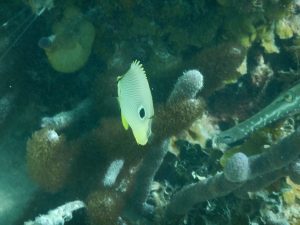Today was a busy day! We woke up at 5 am to get on the bus to go to Glovers Atoll. After a short drive, we arrived at the dock and met our marine safety officers, Javier and Adalfo. We then took a three-hour boat ride to Glovers. The boat ride was a lot of fun! Once we got outside the Great Barrier Reef of Belize, there were huge swells on the boat. A very large sea (approximately 6 feet wide) turtle popped up near the boat to see us. We also spotted lots of brown algae, a few pelicans, and possibly a flying fish.
We arrived at paradise, aka Middle Cay island at approximately 10:40am. We toured the field station and ate lunch. After lunch, we got ready for our first snorkel adventure. We snorkeled directly off the pier of middle cay on a patch reef. There were so many different organisms. I saw one of the largest lobsters I have ever seen peeking out of a hole in the coral. I also saw a yellow stingray swimming above the reef.
On the reef, I saw so many herbivorous fish!!! The first fish I saw was, Acanthurus bahianus, commonly known as the ocean surgeon fish. I also saw the adult form of Acanthurus Coeruleus, the Blue tang surgeon fish with the characteristic yellow caudal spine. The next herbivorous fish I spotted was Chaetodon Capistratus, the four eye butterfly fish swimming above the reef. I also saw Stegastes variables, the cocoa damsel fish, which is primarily yellow with a blue dorsal region. I identified Scarus croicensis, the striped parrot fish, in the initial and terminal phases. The last herbivorous fish I saw was, Sparisoma Viride, the stoplight parrot fish, in the Initial and Juvenile phases. I feel like I notice so many more herbivorous fish now!

After our snorkel trip. We hiked to the coral graveyard and learned how to identify different coral species from their calcium carbonate exoskeletons. I now see coral in a whole new light. I can’t wait to try to identify some of the corals tomorrow.To end the day, we ate dinner and listened to two presentations on Echinoderms and Hard Corals. We also learned how to make a quadrant!

